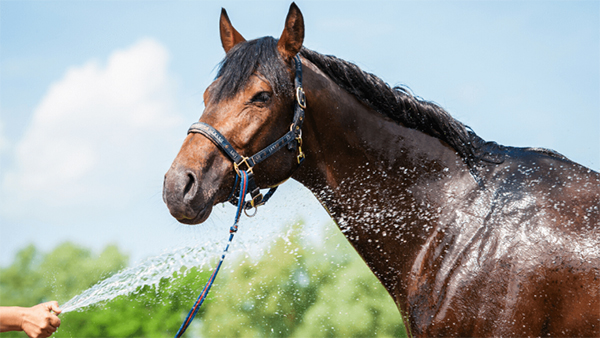Handling 4 of the Most Common Summer Horse Hazards

By: Cait Brown for Alltech
The summer season is generally a favorite among the equestrian crowd, as it not only equates to more riding and training time but also to weekends spent at shows and clinics or out on the trails. In addition, our horses get to enjoy some long-awaited grass and increased turnout time, often trading in bulky winter blankets for lighter fly gear.
Of course, everything has its downsides. I once read a quote that said, “Nothing is ever only good or bad. Everything is somewhere in the middle.” I think the same could most certainly be said about summer, for it brings both respite and risk. With this in mind, let’s explore four of the most commonly concerning summertime hazards associated with horses:
1. Heat stress: It is critical to build an understanding of how to keep horses cool in the summer, especially if you are planning to increase your horse’s time spent working under saddle. Since equines can easily overheat, heat stress in horses is something all equestrians should take very seriously. What may first simply appear to be poor performance can rapidly escalate to potentially fatal heat exhaustion or stroke. If you suspect that your horse is succumbing to overheating, you must act quickly by taking the following steps:
- Walk the horse out. This not only encourages circulation — it also helps bring heated blood to the surface of the skin for cooling and can help regulate body temperature.
- Let the horse drink its fill of cool water. Contrary to popular belief, allowing a hot horse to drink cold water will not cause colic and muscle cramping.
- Splash or spray cold water directly onto the horse and then scrape it off to aid with evaporative cooling. Repeat this process until the skin feels cool to the touch and the horse’s breathing appears to have returned to normal.
If the horse’s behavior and drinking habits have not returned to normal within one hour, or if you witness more significant signs of heat stress before then, contact your veterinarian immediately. Intravenous hydration and other medical measures may be required to prevent potentially irreversible damage or loss of life.
2. Biting flies: Unfortunately, summer and flies are a package deal. And while stable flies and horse flies sometimes seem like nothing more than an ever-present annoyance, fly bites on horses can carry serious implications, such as disease transmission, weight loss, and hoof issues associated with stomping and restlessness. Even the most all-encompassing fly turnout gear can’t keep them completely at bay, but proper sanitation and stable management can go a long way in controlling the fly population of your barn.
Fly management tips:
- Keep manure picked up, and pile it a good distance from facilities, waterers and paddocks.
- Make sure all garbage cans have tight-fitting lids and are cleaned out regularly.
- Keep waterers in good condition and place them away from areas where horses are fed.
- Consider screening any windows in the feed and tack rooms, as well as in box stalls.
- Use fans that direct airflow down and outward. This will help keep flies from entering barns.
- Fly traps and sticky paper are effective means of capturing flies, and they can also be useful in documenting fly numbers over time. A notable increase in flies caught from one week to the next could serve as an alert that it’s time to check on your sanitation measures and improve upon your fly-control techniques.
- Flies generally require a combination of breeding material, ideal moisture and adequate warmth to develop. Therefore, eliminating breeding sites is the key to a successful fly-control program. Barns and paddocks should be thoroughly cleaned once per week to assist in breaking fly life cycles. Insecticides should only be considered as a supplement to fly control.
3. Sweet itch: Contrary to its somewhat sugary-sounding name, sweet itch in horses is a serious nuisance. Also known as summer itch, this seasonal recurrent dermatitis is typically caused by an allergic reaction to a genus of biting midges known as Culicoides, commonly referred to as “no-see-ums” or gnats. Affected horses often become very itchy in the spring and may rub out their manes and tails in an attempt to relieve itchy skin. You may also notice skin irritation along their toplines, jaws, axillary regions and ventral midlines.
Treatment options include supplementing diets with a source of omega-3 fatty acids, providing antihistamines or applying topical creams and insect repellents, but the best course of action is taking steps to prevent or eliminate the presence of these pests. You should regularly remove manure from both stalls and pastures and use stall fans to discourage gnats from lingering. Keep at-risk horses inside at dawn and dusk, as these are the most active feeding hours for midges.
4. Sunburn: Humans have grown increasingly concerned with skin health, especially when it comes to sun-related safety. However, it can be somewhat easy to overlook horse sunburn protection, despite a real need for it — particularly for those with white-skinned areas or pale coats. Sunburn most commonly affects the faces and heels of horses because these areas often have non-pigmented, pink skin patches and less hair coverage. Just as with humans, this condition can not only be painful but is recurrently associated with an increased likelihood of developing skin cancer.
Owners must take preventative measures with horses prone to sunburn, such as stabling during daylight hours and providing overnight turnout time instead. Many human sunscreens are viable options for horses, and those containing zinc oxide are thought to be the most effective. However, you must reapply it at regular intervals for this method to be truly impactful. A full-face fly mask with ears and UV protection may also prove helpful.
For more informative health articles from Alltech, click here.










